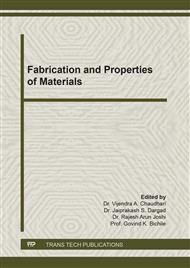[1]
X. D. Bai, E. G. Wang, P. X. Gao, Z. L. Wang, Measuring the work function at a nanobelt tip and at a nanoparticle surface, Nano Lett. 3 (2003) 1147–1150.
DOI: 10.1021/nl034342p
Google Scholar
[2]
K. Vanheusden, W. L. Warren, D. R. Tallent, J. A. Voight, Mechanisms behind green photoluminescence in ZnO phosphor powders, J. Appl. Phys. 79 (1996) 7983–7990.
DOI: 10.1063/1.362349
Google Scholar
[3]
S. Bachiv, C. Sandouly, J. Kossanyi, J.C. Ranford-Haret, Rare earth-doped polycrystalline zinc oxide electroluminescent ceramics, J. Phys. Chem. Solids 57 (1996) 1869–1879.
DOI: 10.1016/s0022-3697(96)00067-4
Google Scholar
[4]
K. J. Albert, N. S. Lewis, C. L. Sahauer, G. A. Sotzing, S. E. Stizel, T. P. Vaid, D. R. Walt, Cross-Reactive chemical sensor arrays, Chem. Rev. 100 (2000) 2595–2626.
DOI: 10.1021/cr980102w
Google Scholar
[5]
B. Z. Dong, G. J. Fang, J. F. Wang, W. J. Guan, X. Z. Zhao, Effect of thickness on structural, electrical and optical properties of ZnO: Al films deposited by Pulsed laser deposition, J. Appl. Phys. 101 (2007) 033713–033719.
DOI: 10.1063/1.2437572
Google Scholar
[6]
Y. F. Chen, D. M. Bagnall, Z. Zhu, T. Sekiuchi, K. T. Park, K. Hiraga, T. Yao, S. Koyama, M. Y. Shen, T. Goto, Growth of ZnO Singal Crystal thin films on c-plane (0001) sapphire by plasma Enhanced molecular beam epitaxy, J. Cryst. Growth 181 (1997) 165–169.
DOI: 10.1016/s0022-0248(97)00286-8
Google Scholar
[7]
G. L. Zhao, B. X. Lin, L. Hong, X. D. Meng, Z. X. Fu, Structural and luminescent properties of ZnO thin films deposited by atmospheric pressure chemical vapour deposition, Chin. Phys. Lett. 21 (2004) 1381–1383.
DOI: 10.1088/0256-307x/21/7/055
Google Scholar
[8]
Z. G. Yao, X. Q. Zhang, H. K. Shang, X. Y. Teng, Y. S. Wang, S. H. Huang, Lasing action of high quality ZnO thin film deposited by radio-frequency magnetron sputtering, Chin. Phys. 14 (2005) 1205–1208.
DOI: 10.1088/1009-1963/14/6/025
Google Scholar
[9]
Ennaqoui, M. Weber, R. Scheer, H. J. Lewerenz, Chemical-bath ZnO buffer Layer for CuInS2 thin-film solar cells, Sol. Energy Mater. Sol. Cells 54 (1992) 277–286.
DOI: 10.1016/s0927-0248(98)00079-8
Google Scholar
[10]
G. T. Yusuf, H. O. Efunwole, M. A. Raimi, O. E. Alaje, A. K. Kazeem, Theoretical models and experimental approaches in physical chemistry, J. Nucl. Phys. Mater. Sci. Rad. Appl. 2 (2014) 73.
Google Scholar
[11]
X. Zhang, S. Ma, F. Yang, Q. Zhao, F. Li, J. Liu, The evolution behaviour of microstructures and optical properties of ZnO film using a Ti buffer layer, Ceram. Inter. 39 (2013) 7993.
DOI: 10.1016/j.ceramint.2013.03.066
Google Scholar
[12]
H. Fan, S. Xu, X. Cao, D. Liu, Y. Yin, H. Hao, D. Wei, Y. Shen, Ultra-long Zn2SnO4-ZnO microwires based gas sensor for hydrogen detection, Appl. Surf. Sci. 400 (2017) 440.
DOI: 10.1016/j.apsusc.2016.12.221
Google Scholar
[13]
K. M. Sandeep, S. Bhat, S. M. Dharmaprakash, Structural, optical and LED characteristics of ZnO and Al doped ZnO thin films, J. Phys. Chem. Solid 104 (2017) 36.
DOI: 10.1016/j.jpcs.2017.01.003
Google Scholar
[14]
P. Malar, S. Kasiviswanathan, A comparative study of CuInSe2 and CuIn3Se5 films using transmission electron microscopy, optical absorption and Rutherford Backscattering spectrometry, Sol. Energy Mater. Sol. Cells 88 (2005) 281–292.
DOI: 10.1016/j.solmat.2004.11.002
Google Scholar
[15]
S. Arunkumar, T. Hou, Y. B. Kim, B. Choi, S. H. Park, S. Jung, D. W. Lee, Au decorated ZnO hierarchical architectures: facile synthesis, tunable morphology and enhanced CO detection at room temperature, Sens. Act. B 243 (2017) 990.
DOI: 10.1016/j.snb.2016.11.152
Google Scholar
[16]
X. Tian, Z. Pan, H. Zhang, Y. Xie, X. Zeng, C. Xiao, G. Hu, Z. Wei, Preparation and characterization of vertically aligned ZnO microrods on glass substrate, Mater. Lett. 97 (2013) 71.
DOI: 10.1016/j.matlet.2013.01.116
Google Scholar
[17]
P. Lu, W. Zhou, Y. Li, J. Wang, P. Wu, Abnormal room temperature ferromagnetism in CuO/ZnO nanocomposites via hydrothermal method, Appl. Surf. Sci. 399 (2017) 396.
DOI: 10.1016/j.apsusc.2016.12.113
Google Scholar


